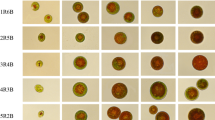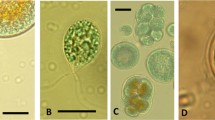Abstract
The engagement of different photoprotective mechanisms in the cells of the carotenogenic astaxanthin-accumulating chlorophyte Haematococcus pluvialis (i) under favorable conditions, (ii) in the course of stress-induced haematocyst formation and (iii) during recovery from the stress was studied. To this end, we followed the changes in primary photochemistry, electron flow at the acceptor side of photosystem II, and non-photochemical quenching (NPQ) using PAM chlorophyll fluorimetry. A general trend recorded in the stressed cells undergoing transition to haematocysts (and reversed during recovery from the stress) was a gradual reduction of the photosynthetic apparatus accompanied by down-regulation of energy-dependent photoprotective mechanisms such as NPQ, along with the accumulation of astaxanthin. On this background, a transient up-regulation of the photosynthetic activity was detected at the intermediated stages (20–50 h of the stress exposure) of haematocyst formation. This phenomenon was tentatively related with the peak of metabolic activity found earlier in the forming haematocysts. The role of secondary carotenogenesis coupled with a reversible transition from ‘active’ (energy-dependent) to ‘passive’ photoprotective mechanisms in the extremely high stress tolerance of carotenogenic phototrophs is discussed.






Similar content being viewed by others
References
Alric J (2010) Cyclic electron flow around photosystem I in unicellular green algae. Photosynth Res 106:47–56
Antal T, Matorin D, Ilyash L, Volgusheva A, Osipov V, Konyuhov I, Krendeleva T, Rubin A (2009) Probing of photosynthetic reactions in four phytoplanktonic algae with a PEA fluorometer. Photosynth Res 102:67–76
Antal TK, Kukarskikh GP, Bulychev AA, Tyystjärvi E, Krendeleva T (2013) Antimycin A effect on the electron transport in chloroplasts of two Chlamydomonas reinhardtii strains. Planta 237:1241–1250
Betterle N, Ballottari M, Zorzan S, de Bianchi S, Cazzaniga S, Dall’Osto L, Morosinotto T, Bassi R (2009) Light-induced dissociation of an antenna hetero-oligomer is needed for non-photochemical quenching induction. J Biol Chem 284:15255–15266
Beuf L, Kurano N, Miyachi S (2000) Effect of external pH on inorganic carbon assimilation in unicellular marine green algae. Phycol Res 48:47–54
Bilger W, Björkman O (1990) Role of the xanthophyll cycle in photoprotection elucidated by measurements of light-induced absorbance changes, fluorescence and photosynthesis in leaves of Hedera canariensis. Photosynth Res 25(3):173–185
Boussiba S (2000) Carotenogenesis in the green alga Haematococcus pluvialis: cellular physiology and stress response. Physiol Plant 108:111–117
Boussiba S, Vonshak A (1991) Astaxanthin accumulation in the green alga Haematococcus pluvialis. Plant Cell Physiol 32:1077–1082
Chekanov K, Lobakova E, Selyakh I, Semenova L, Sidorov R, Solovchenko A (2014) Accumulation of astaxanthin by a new Haematococcus pluvialis strain BM1 from the White Sea coastal rocks (Russia). Mar Drugs 12:4504–4520
Genty B, Briantais JM, Baker NR (1989) The relationship between the quantum yield of photosynthetic electron transport and quenching of chlorophyll fluorescence. BBA-General Subjects 990:87–92
Gilmore A, Ball M (2000) Protection and storage of chlorophyll in overwintering evergreens. Proc Natl Acad Sci 97:11098–11101
Gu W, Xie X, Gao S, Zhou W, Pan G, Wang G (2013) Comparison of different cells of Haematococcus pluvialis reveals an extensive acclimation mechanism during its aging process: from a perspective of photosynthesis. PloS one 8:e67028
Gu W, Li H, Zhao P, Yu R, Pan G, Gao S, Xie X, Huang A, He L, Wang G (2014) Quantitative proteomic analysis of thylakoid from two microalgae (Haematococcus pluvialis and Dunaliella salina) reveals two different high light-responsive strategies. Sci Rep. doi:10.1038/srep06661
Guerin M, Huntley M, Olaizola M (2003) Haematococcus astaxanthin: applications for human health and nutrition. Trends Biotechnol 21:210–216
Guiry M (2011) AlgaeBase.org. www.algaebase.org. Accessed 31 May 2015
Gwak Y, Hwang Y-S, Wang B, Kim M, Jeong J, Lee C-G, Hu Q, Han D, Jin E (2014) Comparative analyses of lipidomes and transcriptomes reveal a concerted action of multiple defensive systems against photooxidative stress in Haematococcus pluvialis. J Exp Bot 65:4317–43334
Han Q, Katahata S, Kakubari Y, Mukai Y (2004) Seasonal changes in the xanthophyll cycle and antioxidants in sun-exposed and shaded parts of the crown of Cryptomeria japonica in relation to rhodoxanthin accumulation during cold acclimation. Tree Physiol 24:609
Hendrickson L, Furbank RT, Chow WS (2004) A simple alternative approach to assessing the fate of absorbed light energy using chlorophyll fluorescence. Photosynth Res 82:73–81
Horton P (2014) Developments in research on non-photochemical fluorescence quenching: emergence of key ideas, theories and experimental approaches. In: Demmig-Adams B, Garab G, Adams Iii W, Govindjee (eds) Non-Photochemical quenching and energy dissipation in plants, algae and cyanobacteria. Advances in photosynthesis and respiration, vol. 40. Springer, Dordrecht, pp 73–95
Kalaji H et al (2014) Frequently asked questions about in vivo chlorophyll fluorescence: practical issues. Photosynth Res 122:121–158
Kereïche S, Kiss AZ, Kouřil R, Boekema EJ, Horton P (2010) The PsbS protein controls the macro-organisation of photosystem II complexes in the grana membranes of higher plant chloroplasts. FEBS Lett 584:759–764
Klochkova TA, Kwak MS, Han JW, Motomura T, Nagasato C, Kim GH (2013) Cold-tolerant strain of Haematococcus pluvialis (Haematococcaceae, Chlorophyta) from Blomstrandhalvøya (Svalbard). Algae 28:185–192
Kramer DM, Johnson G, Kiirats O, Edwards GE (2004) New fluorescence parameters for the determination of QA redox state and excitation energy fluxes. Photosynth Res 79:209–218
Lavergne J, Briantais J-M (1996) Photosystem II heterogeneity. In: Ort DR, Yocum CF (eds) Oxygenic photosynthesis: the light reactions. Advances in photosynthesis and respiration. Springer, Dordretch, pp 265–287
Lazár D (2006) The polyphasic chlorophyll a fluorescence rise measured under high intensity of exciting light. Funct Plant Biol 33:9–30
Li J, Han D, Wang D, Ning K, Jia J, Wei L, Jing X, Huang S, Chen J, Li Y, Hu Q, Xu J (2014) Choreography of transcriptomes and lipidomes of nannochloropsis reveals the mechanisms of oil synthesis in microalgae. The Plant Cell Online. doi:10.1105/tpc.113.121418
Lorenz RT, Cysewski GR (2000) Commercial potential for Haematococcus microalgae as a natural source of astaxanthin. Trends Biotechnol 18:160–167
Maxwell K, Johnson G (2000) Chlorophyll fluorescence-a practical guide. J Exp Bot 51:659–668
Muller P, Li X, Niyogi K (2001) Non-photochemical quenching. A response to excess light energy Plant Physiol 125:1558–1566
Nagy G, Ünnep R, Zsiros O, Tokutsu R, Takizawa K, Porcar L, Moyet L, Petroutsos D, Garab G, Finazzi G, Minagawa J (2014) Chloroplast remodeling during state transitions in Chlamydomonas reinhardtii as revealed by noninvasive techniques in vivo. Proc Natl Acad Sci 111(13):5042–5047
Niyogi K, Li X, Rosenberg V, Jung H (2005) Is PsbS the site of non-photochemical quenching in photosynthesis? J Exp Bot 56:375–382
Pal D, Khozin-Goldberg I, Cohen Z, Boussiba S (2011) The effect of light, salinity, and nitrogen availability on lipid production by Nannochloropsis sp. Appl Microbiol Biotechnol 90:1429–1441. doi:10.1007/s00253-011-3170-1
Peled E, Leu S, Zarka A, Weiss M, Pick U, Khozin-Goldberg I, Boussiba S (2011) Isolation of a novel oil globule protein from the green alga Haematococcus pluvialis (Chlorophyceae). Lipids 46:851–861
Pick U, Rachutin-Zalogin T (2012) Kinetic anomalies in the interactions of Nile red with microalgae. J Microbiol Methods 88:189–196
Ravenel J, Peltier G, Havaux M (1994) The cyclic electron pathways around photosystem I in Chlamydomonas reinhardtii as determined in vivo by photoacoustic measurements of energy storage. Planta 193:251–259
Recht L, Töpfer N, Batushansky A, Sikron N, Gibon Y, Fait A, Nikoloski Z, Boussiba S, Zarka A (2014) Metabolite profiling and integrative modeling reveal metabolic constraints for carbon partitioning under nitrogen-starvation in the green alga Haematococcus pluvialis. J Biol Chem 289:30387–30403
Ruban AV, Johnson MP (2015) Visualizing the dynamic structure of the plant photosynthetic membrane. Nat Plants 1:15161. doi:10.1038/nplants.2015.161
Rumeau D, Peltier G, Cournac L (2007) Chlororespiration and cyclic electron flow around PSI during photosynthesis and plant stress response. Plant Cell Environ 30:1041–1051
Solovchenko A (2011) Pigment composition, optical properties, and resistance to photodamage of the microalga Haematococcus pluvialis cultivated under high light Russ. J Plant Physiol 58:9–17
Solovchenko A (2013) Physiology and adaptive significance of secondary carotenogenesis in green microalgae Russ. J Plant Physiol 60:1–13
Solovchenko A, Aflalo C, Lukyanov A, Boussiba S (2013) Nondestructive monitoring of carotenogenesis in Haematococcus pluvialis via whole-cell optical density spectra. Appl Microbiol Biotechnol 97:4533–4541
Stanier RY, Kunisawa R, Mandel M, Cohen-Bazire G (1971) Purification and properties of unicellular blue-green algae (order Chroococcales). Bacteriol Rev 35:171–205
Stirbet A (2011) On the relation between the Kautsky effect (chlorophyll a fluorescence induction) and photosystem II: basics and applications of the OJIP fluorescence transient. J Photochem Photobiol B Biol 104:236–257
Strasser R, Tsimilli-Michael M, Srivastava A (2004) Analysis of the chlorophyll a fluorescence transient. In: Papageorgiou G, Govindjee (eds) Chlorophyll a fluorescence: a signature of photosynthesis. Springer, Dordrecht, pp 321–362
Sussela M, Toppo K (2006) Haematococcus pluvialis-a green alga, richest natural source of astaxanthin. Curr Sci 90:1602–1603
Tan S, Cunningham FX, Youmans M, Grabowski B, Sun Z, Gantt E (1995) Cytochrome f loss in astaxanthin-accumulating red cells of Haematococcus pluvialis (Chlorophyceae): comparison of photosynthetic activity, photosynthetic enzymes, and thylakoid membrane polypeptides in red and green cells. J Phycol 31:897–905
Tikhonov A (2013) pH-Dependent regulation of electron transport and ATP synthesis in chloroplasts. Photosynth Res 116:511–534
Torzillo G, Goksan T, Faraloni C, Kopecky J, Masojídek J (2003) Interplay between photochemical activities and pigment composition in an outdoor culture of Haematococcus pluvialis during the shift from the green to red stage. J Appl Phycol 15:127–136
Vener A (2007) Environmentally modulated phosphorylation and dynamics of proteins in photosynthetic membranes. BBA-Bioenergetics 1767:449–457
Wang B, Zhang Z, Hu Q, Sommerfeld M, Lu Y, Han D (2014) Cellular capacities for high-light acclimation and changing lipid profiles across life cycle stages of the green alga Haematococcus pluvialis. PLoS ONE 9:e106679. doi:10.1371/journal.pone.0106679
Wayama M, Ota S, Matsuura H, Nango N, Hirata A, Kawano S (2013) Three-dimensional ultrastructural study of oil and astaxanthin accumulation during encystment in the green alga Haematococcus pluvialis. PloS one 8(1):e53618
Zhang K, Kurano N, Miyachi S (2002) Optimized aeration by carbon dioxide gas for microalgal production and mass transfer characterization in a vertical flat-plate photobioreactor Bioprocess. Biosyst Eng 25:97–101
Zhekisheva M, Zarka A, Khozin-Goldberg I, Cohen Z, Boussiba S (2005) Inhibition of astaxanthin synthesis under high irradiance does not abolish triacylglycerol accumulation in the green alga Haematococcus pluvialis (Chlorophyceae). J Phycol 41:819–826
Zlotnik I, Sukenik A, Dubinsky Z (1993) Physiological and photosynthetic changes during the formation of red aplanospores in the chlorophyte Haematococcus pluvialis. J Phycol 29:463–469
Acknowledgments
The authors are thankful to Dr. Aliza Zarka for her invaluable support. Dedicated technical help of Mrs. Emilia Kleiman is greatly appreciated.
Funding
KC, AL, and AS were supported by the Russian Scientific Foundation (Project # 14-50-00029).
Author information
Authors and Affiliations
Corresponding author
Ethics declarations
Conflict of Interest
The authors declare that they have no conflict of interest.
Electronic supplementary material
Below is the link to the electronic supplementary material.
Rights and permissions
About this article
Cite this article
Chekanov, K., Lukyanov, A., Boussiba, S. et al. Modulation of photosynthetic activity and photoprotection in Haematococcus pluvialis cells during their conversion into haematocysts and back. Photosynth Res 128, 313–323 (2016). https://doi.org/10.1007/s11120-016-0246-x
Received:
Accepted:
Published:
Issue Date:
DOI: https://doi.org/10.1007/s11120-016-0246-x




